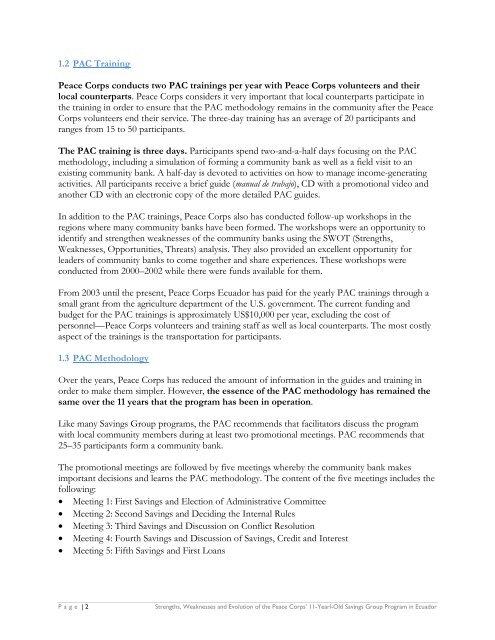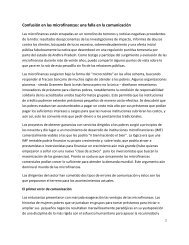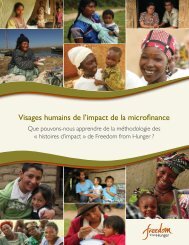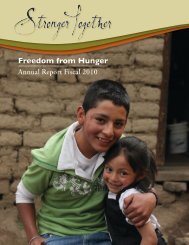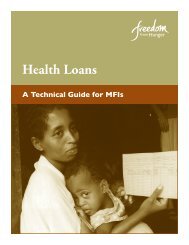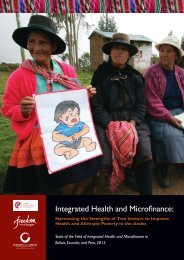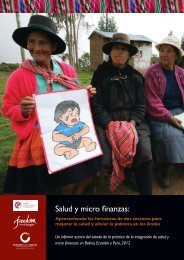Strengths, Weaknesses and Evolution of the Peace Corps' 11-Year ...
Strengths, Weaknesses and Evolution of the Peace Corps' 11-Year ...
Strengths, Weaknesses and Evolution of the Peace Corps' 11-Year ...
Create successful ePaper yourself
Turn your PDF publications into a flip-book with our unique Google optimized e-Paper software.
1.2 PAC Training<br />
<strong>Peace</strong> Corps conducts two PAC trainings per year with <strong>Peace</strong> Corps volunteers <strong>and</strong> <strong>the</strong>ir<br />
local counterparts. <strong>Peace</strong> Corps considers it very important that local counterparts participate in<br />
<strong>the</strong> training in order to ensure that <strong>the</strong> PAC methodology remains in <strong>the</strong> community after <strong>the</strong> <strong>Peace</strong><br />
Corps volunteers end <strong>the</strong>ir service. The three-day training has an average <strong>of</strong> 20 participants <strong>and</strong><br />
ranges from 15 to 50 participants.<br />
The PAC training is three days. Participants spend two-<strong>and</strong>-a-half days focusing on <strong>the</strong> PAC<br />
methodology, including a simulation <strong>of</strong> forming a community bank as well as a field visit to an<br />
existing community bank. A half-day is devoted to activities on how to manage income-generating<br />
activities. All participants receive a brief guide (manual de trabajo), CD with a promotional video <strong>and</strong><br />
ano<strong>the</strong>r CD with an electronic copy <strong>of</strong> <strong>the</strong> more detailed PAC guides.<br />
In addition to <strong>the</strong> PAC trainings, <strong>Peace</strong> Corps also has conducted follow-up workshops in <strong>the</strong><br />
regions where many community banks have been formed. The workshops were an opportunity to<br />
identify <strong>and</strong> streng<strong>the</strong>n weaknesses <strong>of</strong> <strong>the</strong> community banks using <strong>the</strong> SWOT (<strong>Strengths</strong>,<br />
<strong>Weaknesses</strong>, Opportunities, Threats) analysis. They also provided an excellent opportunity for<br />
leaders <strong>of</strong> community banks to come toge<strong>the</strong>r <strong>and</strong> share experiences. These workshops were<br />
conducted from 2000–2002 while <strong>the</strong>re were funds available for <strong>the</strong>m.<br />
From 2003 until <strong>the</strong> present, <strong>Peace</strong> Corps Ecuador has paid for <strong>the</strong> yearly PAC trainings through a<br />
small grant from <strong>the</strong> agriculture department <strong>of</strong> <strong>the</strong> U.S. government. The current funding <strong>and</strong><br />
budget for <strong>the</strong> PAC trainings is approximately US$10,000 per year, excluding <strong>the</strong> cost <strong>of</strong><br />
personnel—<strong>Peace</strong> Corps volunteers <strong>and</strong> training staff as well as local counterparts. The most costly<br />
aspect <strong>of</strong> <strong>the</strong> trainings is <strong>the</strong> transportation for participants.<br />
1.3 PAC Methodology<br />
Over <strong>the</strong> years, <strong>Peace</strong> Corps has reduced <strong>the</strong> amount <strong>of</strong> information in <strong>the</strong> guides <strong>and</strong> training in<br />
order to make <strong>the</strong>m simpler. However, <strong>the</strong> essence <strong>of</strong> <strong>the</strong> PAC methodology has remained <strong>the</strong><br />
same over <strong>the</strong> <strong>11</strong> years that <strong>the</strong> program has been in operation.<br />
Like many Savings Group programs, <strong>the</strong> PAC recommends that facilitators discuss <strong>the</strong> program<br />
with local community members during at least two promotional meetings. PAC recommends that<br />
25–35 participants form a community bank.<br />
The promotional meetings are followed by five meetings whereby <strong>the</strong> community bank makes<br />
important decisions <strong>and</strong> learns <strong>the</strong> PAC methodology. The content <strong>of</strong> <strong>the</strong> five meetings includes <strong>the</strong><br />
following:<br />
Meeting 1: First Savings <strong>and</strong> Election <strong>of</strong> Administrative Committee<br />
Meeting 2: Second Savings <strong>and</strong> Deciding <strong>the</strong> Internal Rules<br />
Meeting 3: Third Savings <strong>and</strong> Discussion on Conflict Resolution<br />
Meeting 4: Fourth Savings <strong>and</strong> Discussion <strong>of</strong> Savings, Credit <strong>and</strong> Interest<br />
Meeting 5: Fifth Savings <strong>and</strong> First Loans<br />
Page | 2 <strong>Strengths</strong>, <strong>Weaknesses</strong> <strong>and</strong> <strong>Evolution</strong> <strong>of</strong> <strong>the</strong> <strong>Peace</strong> Corps’ <strong>11</strong>-<strong>Year</strong>l-Old Savings Group Program in Ecuador


